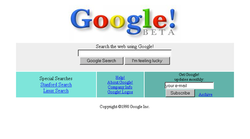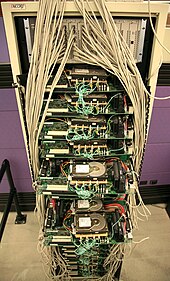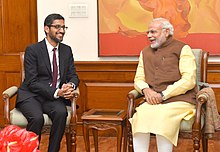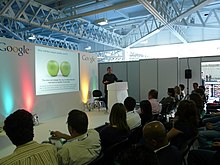Google LLC (/ˈɡuːɡəl/ (
Google was founded on September 4, 1998, by Larry Page and Sergey Brin while they were PhD students at Stanford University in California. Together they own about 14% of its publicly listed shares and control 56% of the stockholder voting power through super-voting stock. The company went public via an initial public offering (IPO) in 2004. In 2015, Google was reorganized as a wholly owned subsidiary of Alphabet Inc. Google is Alphabet's largest subsidiary and is a holding company for Alphabet's Internet properties and interests. Sundar Pichai was appointed CEO of Google on October 24, 2015, replacing Larry Page, who became the CEO of Alphabet. On December 3, 2019, Pichai also became the CEO of Alphabet.[14]
The company has since rapidly grown to offer a multitude of products and services beyond Google Search, many of which hold dominant market positions. These products address a wide range of use cases, including email (Gmail), navigation (Maps), cloud computing (Cloud), web browsing (Chrome), video sharing (YouTube), productivity (Workspace), operating systems (Android), cloud storage (Drive), language translation (Translate), photo storage (Photo), video calling (Meet), smart home (Nest), smartphones (Pixel), wearable technology (Fitbit), gaming (Stadia), music streaming (YouTube Music), video on demand (TV), artificial intelligence (Assistant), machine learning APIs (TensorFlow), AI chips (TPU), and more. Discontinued Google products include Glass, Google+, Reader, Play Music, Nexus, Hangouts, and Inbox by Gmail.[15][16]
Google is known for its highly ambitious technological innovations aimed at solving humanity's biggest problems.[17] Some of these innovations include quantum computing (Sycamore), self-driving cars (Waymo, formerly the Google self-driving project), smart cities (Sidewalk Labs), and transformer models (Google Brain).[18]
Google and YouTube are the two most visited websites worldwide followed by Facebook and Twitter. Google is also the largest search engine, mapping and navigation application, email provider, office suite, video sharing platform, photo and cloud storage provider, mobile operating system, web browser, ML framework, and AI virtual assistant provider in the world as measured by market share. On the list of most valuable brands, Google is ranked second by Forbes[19] and fourth by Interbrand.[20] It has received significant criticism involving issues such as privacy concerns, tax avoidance, censorship, search neutrality, antitrust and abuse of its monopoly position.Google began in January 1996 as a research project by Larry Page and Sergey Brin when they were both PhD students at Stanford University in California.[21][22][23] The project initially involved an unofficial "third founder", Scott Hassan, the original lead programmer who wrote much of the code for the original Google Search engine, but he left before Google was officially founded as a company;[24][25] Hassan went on to pursue a career in robotics and founded the company Willow Garage in 2006.[26][27]
While conventional search engines ranked results by counting how many times the search terms appeared on the page, they theorized about a better system that analyzed the relationships among websites.[28] They called this algorithm PageRank; it determined a website's relevance by the number of pages, and the importance of those pages that linked back to the original site.[29][30] Page told his ideas to Hassan, who began writing the code to implement Page's ideas.[24]
Page and Brin originally nicknamed the new search engine "BackRub", because the system checked backlinks to estimate the importance of a site.[21][31][32] Hassan as well as Alan Steremberg were cited by Page and Brin as being critical to the development of Google. Rajeev Motwani and Terry Winograd later co-authored with Page and Brin the first paper about the project, describing PageRank and the initial prototype of the Google search engine, published in 1998. Héctor García-Molina and Jeff Ullman were also cited as contributors to the project.[33] PageRank was influenced by a similar page-ranking and site-scoring algorithm earlier used for RankDex, developed by Robin Li in 1996, with Larry Page's PageRank patent including a citation to Li's earlier RankDex patent; Li later went on to create the Chinese search engine Baidu.[34][35]
Eventually, they changed the name to Google; the name of the search engine was a play on the word googol,[21][36][37] a very large number written 10100 (1 followed by 100 zeros), picked to signify that the search engine was intended to provide large quantities of information.[38]
The domain name www.google.com was registered on September 15, 1997,[40] and the company was incorporated on September 4, 1998. It was based in the garage of Susan Wojcicki[23] in Menlo Park, California. Craig Silverstein, a fellow PhD student at Stanford, was hired as the first employee.[23][41][42]
Google was initially funded by an August 1998 investment of $100,000 from Andy Bechtolsheim,[21] co-founder of Sun Microsystems, a few weeks prior to September 7, 1998, the day Google was officially incorporated. This initial investment served as a motivation to incorporate the company to be able to use the funds.[43][44] Page and Brin initially approached David Cheriton for advice because he had a nearby office in Stanford, and they knew he had startup experience, having recently sold the company he co-founded, Granite Systems, to Cisco for $220 million. David arranged a meeting Page and Brin and his Granite co-founder Andy Bechtolsheim. The meeting was set for 8 AM at the front porch of David's home in Palo Alto and it had to be brief because Andy had another meeting at Cisco, where he now worked after the acquisition, at 9 AM. Andy briefly tested a demo of the website, liked what he saw, and then went back to his car to grab the check. David Cheriton later also joined in with an $250,000 investment.[45][46]
Google received money from two other angel investors in 1998: Amazon.com founder Jeff Bezos, and entrepreneur Ram Shriram.[47] Page and Brin had first approached Shriram, who was a venture capitalist, for funding and council, and Shriram invested $250,000 in Google on February 1998. Shriram knew Bezos because Amazon had acquired Junglee, at which Shriram was the president. It was Shriram who told Bezos about Google. Bezos asked Shriram to meet Google's founders and they met 6 months after Shriram had made his investment when Bezos and his wife were in a vacation trip to the Bay Area. Google's initial funding round had already formally closed but Bezos' status as CEO of Amazon was enough to persuade Page and Brin to extend the round and accept his investment.[48][49]
Between these initial investors, friends, and family Google raised around $1,000,000, which is what allowed them to open up their original shop in Menlo Park, California.[50]
After some additional, small investments through the end of 1998 to early 1999,[47] a new $25 million round of funding was announced on June 7, 1999,[51] with major investors including the venture capital firms Kleiner Perkins and Sequoia Capital.[44] Both firms were initially reticent about investing jointly in Google, as each wanted to retain a larger percentage of control over the company to themselves. Larry and Sergey however insisted in taking investments from both. Both venture companies finally agreed to investing jointly $12.5 million each due to their belief in Google's great potential and through mediation of earlier angel investors Ron Conway and Ram Shriram who had contacts in the venture companies.[52]
Growth
In March 1999, the company moved its offices to Palo Alto, California,[53] which is home to several prominent Silicon Valley technology start-ups.[54] The next year, Google began selling advertisements associated with search keywords against Page and Brin's initial opposition toward an advertising-funded search engine.[55][23] To maintain an uncluttered page design, advertisements were solely text-based.[56] In June 2000, it was announced that Google would become the default search engine provider for Yahoo!, one of the most popular websites at the time, replacing Inktomi.[57][58]
In 2003, after outgrowing two other locations, the company leased an office complex from Silicon Graphics, at 1600 Amphitheatre Parkway in Mountain View, California.[60] The complex became known as the Googleplex, a play on the word googolplex, the number one followed by a googol zeroes. Three years later, Google bought the property from SGI for $319 million.[61] By that time, the name "Google" had found its way into everyday language, causing the verb "google" to be added to the Merriam-Webster Collegiate Dictionary and the Oxford English Dictionary, denoted as: "to use the Google search engine to obtain information on the Internet".[62][63] The first use of the verb on television appeared in an October 2002 episode of Buffy the Vampire Slayer.[64]
Additionally, in 2001 Google's Investors felt the need to have a strong internal management, and they agreed to hire Eric Schmidt as the chairman and CEO of Google.[50] Eric was proposed by John Doerr from Kleiner Perkins. He had been trying to find a CEO that Sergey and Larry would accept for several months, but they rejected several candidates because they wanted to retain control over the company. Michael Moritz from Sequoia Capital at one point even menaced requesting Google to immediately pay back Sequoia's $12.5m investment if they did not fulfill their promise to hire a chief executive office, which had been made verbally during investment negotiations. Eric wasn't initially enthusiastic about joining Google either, as the company's full potential hadn't yet been widely recognized at the time, and as he was occupied with his responsibilities at Novell where he was CEO. As part of him joining, Eric agreed to buy $1 million of Google preferred stocks as a way to show his commitment and to provide funds Google needed.[65]
Initial public offering
On August 19, 2004, Google became a public company via an initial public offering. At that time Larry Page, Sergey Brin, and Eric Schmidt agreed to work together at Google for 20 years, until the year 2024.[66] The company offered 19,605,052 shares at a price of $85 per share.[67][68] Shares were sold in an online auction format using a system built by Morgan Stanley and Credit Suisse, underwriters for the deal.[69][70] The sale of $1.67 billion gave Google a market capitalization of more than $23 billion.[71]
On November 13, 2006, Google acquired YouTube for $1.65 billion in Google stock,[72][73][74][75] On March 11, 2008, Google acquired DoubleClick for $3.1 billion, transferring to Google valuable relationships that DoubleClick had with Web publishers and advertising agencies.[76][77]
By 2011, Google was handling approximately 3 billion searches per day. To handle this workload, Google built 11 data centers around the world with several thousand servers in each. These data centers allowed Google to handle the ever-changing workload more efficiently.[50]
In May 2011, the number of monthly unique visitors to Google surpassed one billion for the first time.[78][79]
In May 2012, Google acquired Motorola Mobility for $12.5 billion, in its largest acquisition to date.[80][81][82] This purchase was made in part to help Google gain Motorola's considerable patent portfolio on mobile phones and wireless technologies, to help protect Google in its ongoing patent disputes with other companies,[83] mainly Apple and Microsoft,[84] and to allow it to continue to freely offer Android.[85]
2012 onward
In June 2013, Google acquired Waze, a $966 million deal.[86] While Waze would remain an independent entity, its social features, such as its crowdsourced location platform, were reportedly valuable integrations between Waze and Google Maps, Google's own mapping service.[87]
Google announced the launch of a new company, called Calico, on September 19, 2013, to be led by Apple Inc. chairman Arthur Levinson. In the official public statement, Page explained that the "health and well-being" company would focus on "the challenge of ageing and associated diseases".[88]
On January 26, 2014, Google announced it had agreed to acquire DeepMind Technologies, a privately held artificial intelligence company from London.[89] Technology news website Recode reported that the company was purchased for $400 million, yet the source of the information was not disclosed. A Google spokesperson declined to comment on the price.[90][91] The purchase of DeepMind aids in Google's recent growth in the artificial intelligence and robotics community.[92]
According to Interbrand's annual Best Global Brands report, Google has been the second most valuable brand in the world (behind Apple Inc.) in 2013,[93] 2014,[94] 2015,[95] and 2016, with a valuation of $133 billion.[96]
On August 10, 2015, Google announced plans to reorganize its various interests as a conglomerate named Alphabet Inc. Google became Alphabet's largest subsidiary and the umbrella company for Alphabet's Internet interests. Upon completion of the restructuring, Sundar Pichai became CEO of Google, replacing Larry Page, who became CEO of Alphabet.[97][98][99]
On August 8, 2017, Google fired employee James Damore after he distributed a memo throughout the company that argued bias and "Google's Ideological Echo Chamber" clouded their thinking about diversity and inclusion, and that it is also biological factors, not discrimination alone, that cause the average woman to be less interested than men in technical positions.[100] Google CEO Sundar Pichai accused Damore in violating company policy by "advancing harmful gender stereotypes in our workplace", and he was fired on the same day.[101][102][103]
Between 2018 and 2019, tensions between the company's leadership and its workers escalated as staff protested company decisions on internal sexual harassment, Dragonfly, a censored Chinese search engine, and Project Maven, a military drone artificial intelligence, which had been seen as areas of revenue growth for the company.[104][105] On October 25, 2018, The New York Times published the exposé, "How Google Protected Andy Rubin, the 'Father of Android'". The company subsequently announced that "48 employees have been fired over the last two years" for sexual misconduct.[106] On November 1, 2018, more than 20,000 Google employees and contractors staged a global walk-out to protest the company's handling of sexual harassment complaints.[107][108] CEO Sundar Pichai was reported to be in support of the protests.[109] Later in 2019, some workers accused the company of retaliating against internal activists.[105]
On March 19, 2019, Google announced that it would enter the video game market, launching a cloud gaming platform called Google Stadia.[110]
On June 3, 2019, the United States Department of Justice reported that it would investigate Google for antitrust violations.[111] This led to the filing of an antitrust lawsuit in October 2020, on the grounds the company had abused a monopoly position in the search and search advertising markets.[112]
In December 2019, former PayPal chief operating officer Bill Ready became Google's new commerce chief. Ready's role will not be directly involved with Google Pay.[113]
In April 2020, due to the COVID-19 pandemic, Google announced several cost-cutting measures. Such measures included slowing down hiring for the remainder of 2020, except for a small number of strategic areas, recalibrating the focus and pace of investments in areas like data centers and machines, and non-business essential marketing and travel.[114]
The 2020 Google services outages disrupted Google services: one in August that affected Google Drive among others, another in November affecting YouTube, and a third in December affecting the entire suite of Google applications. All three outages were resolved within hours.[115][116][117]
In 2021, the Alphabet Workers Union was founded, composed mostly of Google employees.[118]
In January 2021, the Australian Government proposed legislation that would require Google and Facebook to pay media companies for the right to use their content. In response, Google threatened to close off access to its search engine in Australia.[119]
In March 2021, Google reportedly paid $20 million for Ubisoft ports on Google Stadia.[120] Google spent "tens of millions of dollars" on getting major publishers such as Ubisoft and Take-Two to bring some of their biggest games to Stadia.[121]
In April 2021, The Wall Street Journal reported that Google ran a years-long program called "Project Bernanke" that used data from past advertising bids to gain an advantage over competing for ad services. This was revealed in documents concerning the antitrust lawsuit filed by ten US states against Google in December.[122]
In September 2021, the Australian government announced plans to curb Google’s capability to sell targeted ads, claiming that the company has a monopoly on the market harming publishers, advertisers, and consumers.[123]
In 2022, Google began accepting requests for the removal of phone numbers, physical addresses and email addresses from its search results. It had previously accepted requests for removing confidential data only, such as Social Security numbers, bank account and credit card numbers, personal signatures, and medical records. Even with the new policy, Google may remove information from only certain but not all search queries. It would not remove content that is "broadly useful", such as news articles, or already part of the public record.[124]
In May 2022, Google announced that the company had acquired California based, MicroLED display technology development and manufacturing Start-up Raxium. Raxium is set to join Google’s Devices and Services team to aid in the development of micro-optics, monolithic integration, and system integration.[125]
Products and services
Search engine
Google indexes billions of web pages to allow users to search for the information they desire through the use of keywords and operators.[126] According to comScore market research from November 2009, Google Search is the dominant search engine in the United States market, with a market share of 65.6%.[127] In May 2017, Google enabled a new "Personal" tab in Google Search, letting users search for content in their Google accounts' various services, including email messages from Gmail and photos from Google Photos.[128][129]
Google launched its Google News service in 2002, an automated service which summarizes news articles from various websites.[130] Google also hosts Google Books, a service which searches the text found in books in its database and shows limited previews or and the full book where allowed.[131]
Advertising
Google generates most of its revenues from advertising. This includes sales of apps, purchases made in-app, digital content products on Google and YouTube, Android and licensing and service fees, including fees received for Google Cloud offerings. Forty-six percent of this profit was from clicks (cost per clicks), amounting to US$109,652 million in 2017. This includes three principal methods, namely AdMob, AdSense (such as AdSense for Content, AdSense for Search, etc.) and DoubleClick AdExchange.[132]
In addition to its own algorithms for understanding search requests, Google uses technology its acquisition of DoubleClick, to project user interest and target advertising to the search context and the user history.[133][134]
In 2007, Google launched "AdSense for Mobile", taking advantage of the emerging mobile advertising market.[135]
Google Analytics allows website owners to track where and how people use their website, for example by examining click rates for all the links on a page.[136] Google advertisements can be placed on third-party websites in a two-part program. Google Ads allows advertisers to display their advertisements in the Google content network, through a cost-per-click scheme.[137] The sister service, Google AdSense, allows website owners to display these advertisements on their website and earn money every time ads are clicked.[138] One of the criticisms of this program is the possibility of click fraud, which occurs when a person or automated script clicks on advertisements without being interested in the product, causing the advertiser to pay money to Google unduly. Industry reports in 2006 claimed that approximately 14 to 20 percent of clicks were fraudulent or invalid.[139] Google Search Console (rebranded from Google Webmaster Tools in May 2015) allows webmasters to check the sitemap, crawl rate, and for security issues of their websites, as well as optimize their website's visibility.
Software
Google develops the Android mobile operating system,[155] as well as its smartwatch,[156] television,[157] car,[158] and Internet of things-enabled smart devices variations.[159]
It also develops the Google Chrome web browser,[160] and Chrome OS, an operating system based on Chrome.[161]
Hardware
In January 2010, Google released Nexus One, the first Android phone under its own brand.[162] It spawned a number of phones and tablets under the "Nexus" branding[163] until its eventual discontinuation in 2016, replaced by a new brand called Pixel.[164]
In 2011, the Chromebook was introduced, which runs on Chrome OS.[165]
In July 2013, Google introduced the Chromecast dongle, which allows users to stream content from their smartphones to televisions.[166][167]
In June 2014, Google announced Google Cardboard, a simple cardboard viewer that lets user place their smartphone in a special front compartment to view virtual reality (VR) media.[168]
Other hardware products include:
- Nest, a series of voice assistant smart speakers that can answer voice queries, play music, find information from apps (calendar, weather etc.), and control third-party smart home appliances (users can tell it to turn on the lights, for example). The Google Nest line includes the original Google Home[169] (later succeeded by the Nest Audio), the Google Home Mini (later succeeded by the Nest Mini, the Google Home Max, the Google Home Hub (later rebranded as the Nest Hub), and the Nest Hub Max.
- Nest Wifi (originally Google Wifi), a connected set of Wi-Fi routers to simplify and extend coverage of home Wi-Fi.









No comments:
Post a Comment